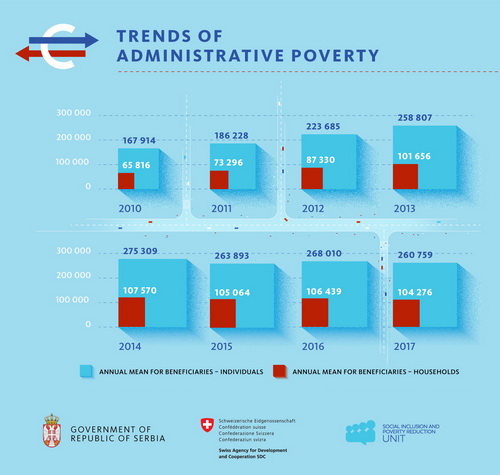In addition to statistical monitoring of poverty – either as absolute poverty (the minimum required for existence, i.e. consumption required to satisfy minimum living needs) or relative poverty (as those ranked “worse” within the society they live in, i.e. persons whose income by consumer unit is below 60% of the median equivalent income), states also use legal criteria for definitions used to recognize certain persons as poor.
Who are the people in administrative poverty? They are persons eligible for social welfare and other social handouts provided with a view to the financial situation in the given country.
The main welfare programme for the poor in Serbia is being implemented through financial social assistance in the form of guaranteed minimum income aimed at providing a minimum living standard. The right to financial social assistance (FSA) is defined by the Law on Social Protection.
Assistance is being awarded after a review of a person’s income and property, and is paid under the principle of supplements to the legally defined (national) poverty threshold. In practice, this means that a person with no income receives the full amount, while persons with income below this amount receive only the difference up to the poverty threshold. The poverty threshold, i.e. the administrative poverty line, is defined as a natural census expressed in the form of a basis for establishing the amount of FSA, harmonized every six months with the consumer price index. The value of the basis for a number of years can be found on the following link.
According to data for 2017, the administrative poverty line per income in Serbia was RSD 8,120 by equivalent adult.
Assistance is aimed at the entire family/household and observes differences in the age structure and size of the household. For an individual, i.e. the bearer of the right, the maximum amount of assistance is equal to the amount of the base, whereas a 0.5 weighting factor of the base amount is used for each subsequent adult member, while for a child the weighting factor is 0.3. Furthermore, financial social assistance is increased by 20% for households where all members are not able to work, and for single parent families.
This means that during 2017 a child in a family would receive financial social assistance to a maximum amount of RSD 2,436 per month, and a subsequent adult RSD 4,060.
How many people are in administrative poverty in Serbia? During 2017, a total of 260 thousand individuals (3.7% of the total population number), i.e. 104 thousand households were in administrative poverty. The number of persons in administrative poverty increased significantly every year after the amendments to the Law on Social Assistance in 2011, until 2014 when a trend of decrease was noted.
The administrative poverty line is significantly lower than the threshold of relative (income) poverty, but also the threshold of absolute poverty.
Beneficiaries and annual expenditures for FSA (in RSD million and % of GDP) during 2010-2017
| Year | Beneficiaries – annual average | Annual expenditures | ||
| Households | Individuals | In millions of RSD | Share in GDP | |
| 2010. | 65,816 | 167,914 | 5,147.8 | 0.18 |
| 2011. | 73,629 | 186,228 | 8,069.5 | 0.25 |
| 2012. | 87,330 | 223,685 | 10,270.5 | 0.30 |
| 2013. | 101,656 | 258,807 | 12,801.4 | 0.34 |
| 2014. | 107,570 | 275,309 | 14,416.1 | 0.37 |
| 2015. | 105,064 | 263,893 | 14,103.8 | 0.35 |
| 2016. | 106,439 | 268,010 | 14,304.1 | 0.34 |
| 2017. | 104,276 | 260,759 | 14,563.6 | 0.33 |
Source: Ministry of Labour, Employment, Veteran and Social Affairs
The lowest welfare rate is for vulnerable groups in Belgrade (1.3% of the population of this region is receiving FSA). In AP Vojvodina and the region of Eastern and Southern Serbia, the rate is approximately 5.0%, while in the region of Šumadija and Western Serbia approximately 3% of the population is receiving welfare.
A detailed overview of the number of households using FSA through the years, by region, area and local self-government unit, is available at the following link.
The form for the Request for exercising the right to financial social assistance, overview of income and revenues of relevance for exercising the right to financial social assistance, and other documents and information of relevance for exercising the right can be found at the following link.
 Government of the Republic of Serbia
Government of the Republic of Serbia












 pdf [271 KB]
pdf [271 KB]